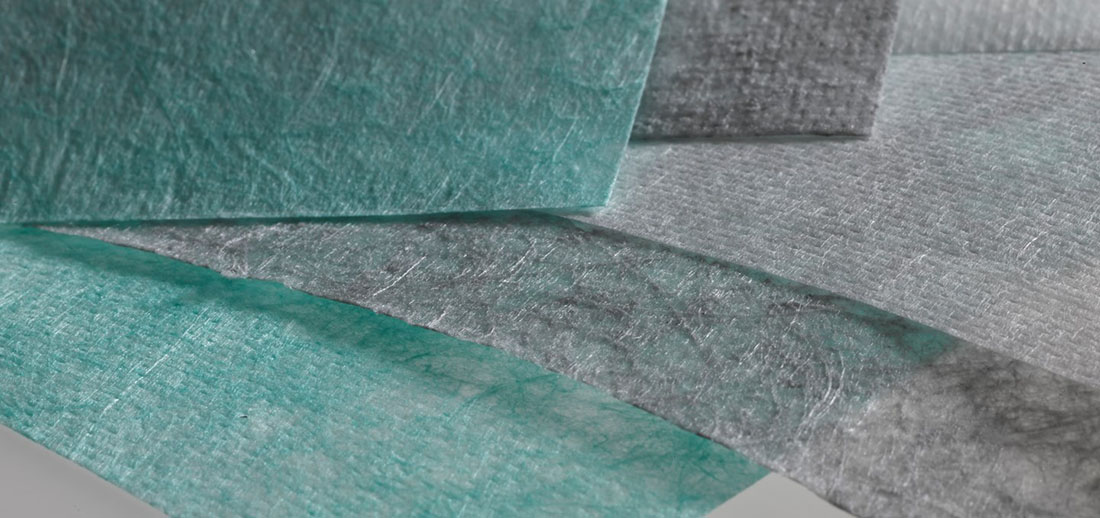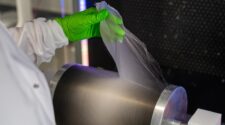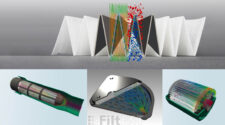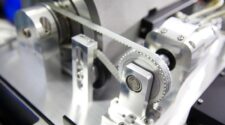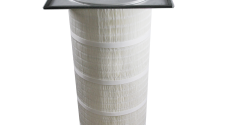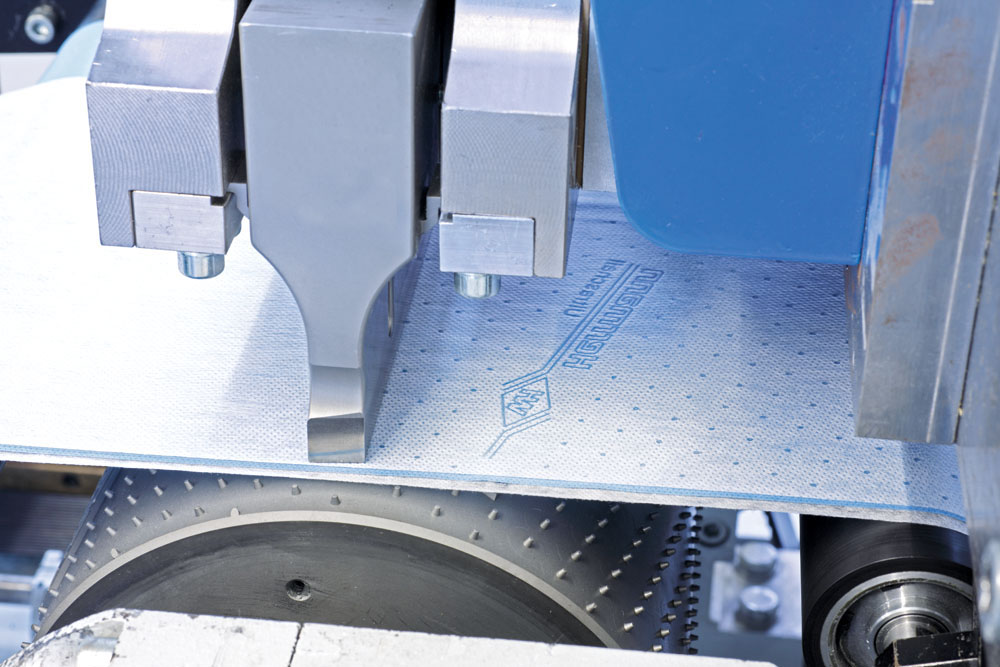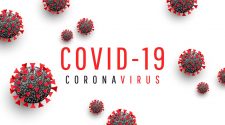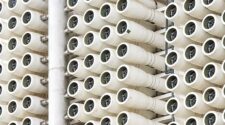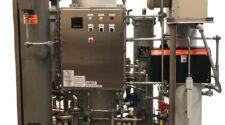Meltblown has risen from a commodity nonwoven material for select applications to front-and-center in the response to the COVID-19 pandemic.
Meltblown is created via an integrated extrusion process. It utilizes a stream of hot, high-velocity air to blow a molten thermoplastic resin from an extruder die tip onto a forming belt or rotary conveyor with a vacuum underneath to form a nonwoven web. The process has been in existence since the 1950s and has grown in significance since its origins.
Why meltblown?
Meltblown is an ideal material for personal protective equipment, facemasks and other filtration media for a number of reasons. First, its structure meets the basic filtration and barrier requirements of these products. Second, and equally important, it can be made very efficiently in comparison to other materials. Lastly, meltblown materials are relatively easy to fabricate into finished products.
Research shows that from an overall performance perspective, meltblown materials have outperformed other material options. Aside from pore size, fiber size and price, the added electrostatic feature common to meltblown media really sets this technology apart from all the rest by boosting the filtration efficiency in the particle range of the SARS-CoV-2 virus.
Other media suffer from higher pressure drops at similar filtration efficiencies, which makes facemasks, for instance, harder to breathe through. Meltblown’s optimal filtration efficiency combined with its low pressure drop makes this material ideally suited for facemasks that are both effective and comfortable.
From a manufacturing perspective, meltblown was very hard to come by during the early stages of the pandemic, particularly in the U.S. and Europe, for two main reasons: First, meltblown for COVID-19 applications were commodity products, which were made in proximity to finished products, like facemasks and surgical gowns, primarily in Taiwan and China; Second, meltblown media assets were contractually linked to other applications or were not able to produce proper grades.
As the pandemic took hold worldwide, there were significant investments to bring additional meltblown capacity online. In absolute terms, from 2020 to 2021, global meltblown capacity will increase by 122,350 tonnes, which is an outright increase of 21.5%. That is a very large increase in global production, and at this specific moment in time, with COVID-19 still a threat, this capacity is needed. However, as the use of face covering begins to subside, there is going to be a significant amount of filtration-grade meltblown in the marketplace for other applications. This media would fill a void, specifically in the United States for MERV 13 filters, which are recommended by the CDC and ASHRAE as high occupancy buildings begin to reopen amid COVID.
Meltblown materials are hard to usurp because of their outstanding performance and price point. However, from the increasingly scrutinized lens of single-use plastics, change is inevitable.
Other factors to consider
In tandem with the investment to bring on additional meltblown capacity, there have been efforts to develop material alternatives to meltblown for PPE and facemasks. Some of the more promising alternative material options include nanofiber and membrane composites.
For example, NXTNano of Claremore, Oklahoma, has developed a process it calls “hyprspinning,” a derivative of traditional electrospinning, but it enables nanofiber to be manufactured at a commercially viable rate, overcoming a key obstacle to the technology achieving more widespread use. This advance has allowed the company to help meet the demand for facemask materials during the COVID-19 pandemic.
Another example of a recent material advance is the product of a partnership between North Carolina State’s Nonwovens Institute and NatureWorks, of Minnetonka, Minnesota. The two organizations have developed a new spunbond-based facemask filter medium leveraging bicomponent PLA (polylactic acid) and PP (polypropylene) fiber for a material that provides ultra-low pressure drop and outstanding filtration efficiency. This new structure also does not require electrostatic charging and can be reused and re-sterilized, and it is strong enough to be cut and sewn, or automatically converted into masks and respirators.
A crisis like COVID-19 presents the industry with unique conditions that allow innovators to think and move more freely to create rapid, impactful change. The primary obstacle for these materials for PPE has been testing, as new materials and new entrants to the market have turned validation into a bottleneck.
Bonus ’Tech Talk’ Video
Learn More @ inda.org/education!
Sustainability is also an issue to consider regarding meltblown, as meltblown-based PPE and facemasks are essentially single-use plastics and are less-than-ideal from an environmental impact perspective. Likewise, the potential to recover polymers from mixed healthcare waste, including PPE, is challenging.
Research since the beginning of the COVID-19 pandemic indicates that PPE disinfection and reuse is possible on a large scale through methods such as infusion of hydrogen peroxide vapor, ultraviolet or gamma-irradiation, ethylene oxide gasification, application of spray-on disinfectants, and infusion of base materials with antimicrobial nanoparticles. These methods disinfect, but do not address cleaning. Alternate facemasks and PPE made from woven materials can provide greater opportunity for reuse and environmental sustainability, but lack the high performance of meltblown. Innovation in this area is an analogue to sustainability in general, infrastructure and technology have not caught up to the need, at least not at the time of this writing.
The future
The future of meltblown for facemasks and PPE is still the gold standard in the near term, and it will become more widespread as capacity continues to come on line around the world. Meltblown materials are hard to usurp because of their outstanding performance and price point. However, from the increasingly scrutinized lens of single-use plastics, change is inevitable. My guess is it will come in the form of a more robust recycling infrastructure or in a new technology that provides equivalent performance with a single polymer or a natural fiber. All materials have an environmental impact. There are good reasons certain products are designed for just one use, many of which center around promoting health and hygiene, and meltblown fits that use case.
As director of education and technical affairs, Chris presents regular training related to nonwovens and filter media from INDA’s headquarters in Cary, NC. For more information about upcoming training opportunities, visit inda.org/education.
* International Filtration News is owned by INDA, Association of the Nonwoven Fabrics Industry (inda.org).


